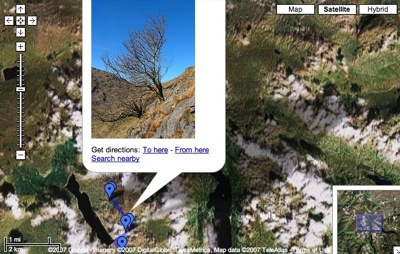Looking back on this post before I fire it off it seems even more of a mixed bag than usual. As usual fairly garbled, but the first half contains some wonderful links and the second what looks to me to be a great resource.
I spent the first part of yesterday morning (and the last hour or so this morning) following a trail that either started in a tweet from cogdog or a post recent addition to my feed reader.
Tony Hirst’s OUseful Info is a great source of ‘mostly over my head’ mashup info and other stuff, eg: We Ignore RSS at OUr Peril or « feedshow – A Feed Powered Web Page Presentation Tool
To Comrades in Non-Programistan – A Message from Feedistan included a great youtube: DataPortability and Me (Get Your Data Out!) and had me laughing. It also pointed to The Party Line of The Peoples Republic of Non-Programistan which was created (as far as I can see) to support a presentation at the Symposium on Mashups, you an watch the recording of the Welcome to the People?s Republic of Non-Programistan session which features laugh out loud fake Russian accents.
The point of the Non-Programistana is to open up mashups to non-coders, although they will allow some html. They point to Exhibit and give interesting examples: Industrial Warfare – Version 4.
This lead me to Exhibit part of MITs SIMILE Project:
SIMILE is focused on developing robust, open source tools that empower users to access, manage, visualize and reuse digital assets.
Exhibit can be used to
Create interactive data-rich web pages
and there are some great examples that can be popped from the Exhibit homepage.
I have been talking to some Glasgow colleagues about filling the 5-14 database gap that has appeared when we got upgraded to windows xp. I had suggested a few online examples that children could use for querying databases and Zoho Create for creating databases. While the querying examples went down well, Zoho seemed too imageless for catching primary children’s imagination. It also look a little like a spreadsheet for some teachers. likewise lazybase.

Exhibit looked like it might fill this gap, so I’ve spent the rest of yesterday morning playing with it. The Getting Started tutorial is very straightforward and will allow you to work through an example on your own desktop. I started with an idea from our own curriculum, information about the EU. The idea is that the children could research basic facts about the EU and add them to a google spreadsheet. With the number of countries in the EU a fair sized class could get one country each.
Exhibit allows you to build a simple html page which will read the spreadsheet webpage and create an interactive database. Amazingly it allows multiple views including a nice timeline and table views. One of the Exhibit examples incorporated famfamfam.com flag icons, interestingly these are name with ISO 3166-1 alpha-2 country codes, I could add a column to the spread sheet and include these, it was the easy to show the flag on the records:
I have been playing with Google chart maps, which use the same iso code so it was simple enough to add these.
Anyway in a couple of hours i was able to put together a google spreadsheet and a Exhibit Test. The latter will need more work, but you can get the idea. I think this will work in class and hope to try it out next term. I need to know a bit more about logging on multiple uses with the same ip address to a spreadsheet, but I hope to quiz Tom Barrett about that. I also need to find out a bit more about creating forms for google speadsheets.
The workflow would go like this:
- I’d start a spreadsheet with the correct column headers
- Put together a webpage to pull the data via exhibit.
- The children would research the required info (wikipedia)
- the children would add the info to the spreadsheet, directly or via a form
- The children would query the webpage to compare EU countries.
At the moment this would only work as a one off, a webpage would have to be created for each time the lesson was carried out for a class. A quick look at the Google Spreadsheets Data API would suggest you could create a spreadsheet automatically, by uploading a blank this could then be loaded by a hph version of the Exhibit Test page which would dynamically load different spreadsheets (with the same headers). Unfortunately this would violate the Party Line of The Peoples Republic of Non-Programistan, and more realistically be beyond my limited skills.
As I just wrote at the start of this post, it is a bit of a rag bag, but it tells the tale of my Sunday morning’s fun, following a web of links and playing with a great tool. In the afternoon I went for a walk






